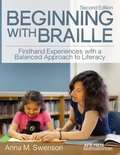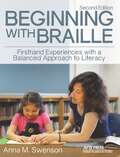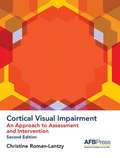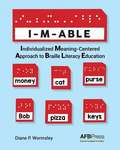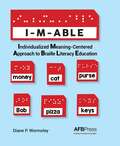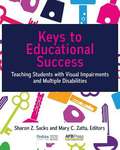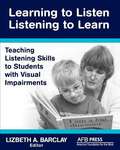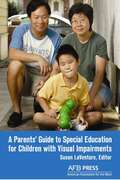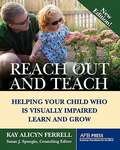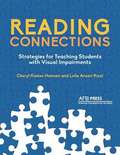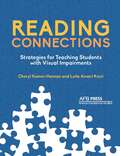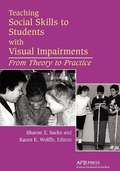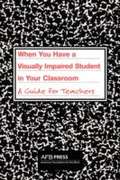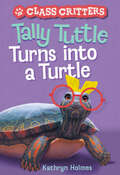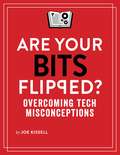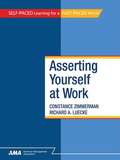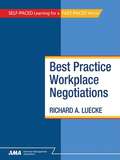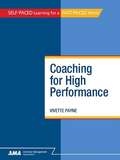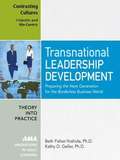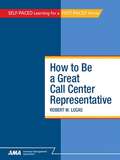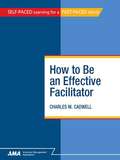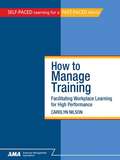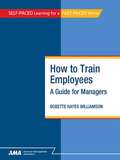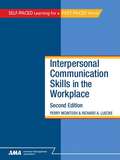- Table View
- List View
Beginning With Braille: Firsthand Experiences With A Balanced Approach To Literacy
by Anna M SwensonBeginning with Braille, the illuminating classic written by a master teacher and beloved by readers in the United States and abroad, has been expanded and revised This exceptional resource that has been an essential guide to helping educators teach braille to readers who are visually impaired contains invaluable new sections on a range of critical topics, including trends in general education literacy instruction and the teaching of braille, working with dual-media learners, and addressing diverse needs effectively. Updated with UEB, the second edition also includes new teaching materials, record forms, and braille activities.
Beginning with Braille
by Anna M. SwensonWritten by a gifted practitioner, Beginning with Braille offers teachers a variety of practical strategies for designing and delivering braille instruction. This guide emphasizes the balance between a meaning-centered approach and braille reading skills for early literacy and beginning readers and writers, as well as children with multiple disabilities. It provides suggestions for reading aloud to young children, selecting and making early tactile books, and teaching tactile and hand movement skills, as well as tips on the braille writing process. Reading Beginning with Braille, with its numerous suggestions and examples, is like having a mentor by your side.
College Bound
by Ellen TriefThe transition from high school to college is a significant turning point in a student's life, and this easy-to-read guide gives students the tools they need to select and apply to college and move forward with skill and confidence. Everything a student needs to know is included, from developing organizational, note-taking, test-taking, and study skills to managing living space, student-teacher relationships, social and academic life, and extracurricular and leisure time activities is included.
Cortical Visual Impairment: An Approach To Assessment And Intervention (Second Edition)
by Christine Roman-LantzyCortical Visual Impairment: An Approach to Assessment and Intervention provides educators, therapists, physicians, and parents of children with CVI with an understanding of the condition and a complete framework for assessment and intervention. The new and revised content in this second edition brings the book up-to-date with new research and insights into CVI, its development and progression, and the best approaches to assessment and intervention with children affected by this condition. As in the previous edition, assessment forms, including the CVI Range and CVI Progress Chart, provide a comprehensive method for evaluating the functional vision status of, and program planning for, children with CVI.
I-m-able: Individualized Meaning-centered Approach To Braille Literacy Education
by Diane P. WormsleyI-M-ABLE, or the Individualized Meaning-Centered Approach to Braille Literacy Education, is an innovative, individualized, student-centered method for teaching braille and making it exciting for children who have difficulties learning braille. In this teaching approach, instruction is centered on continuously analyzing the strengths and needs of students, placing particular emphasis on engaging them using key vocabulary words and phrases based on their experiences and interests. This comprehensive practice guide provides detailed direction on how to implement the components of the approach. Teachers will find this resource invaluable for helping students with mild to moderate cognitive impairments or other difficulties make progress in braille reading and writing, and all the skills that it encompasses.
I-m-able
by Diane P. WormsleyI-M-ABLE, or the Individualized Meaning-Centered Approach to Braille Literacy Education, is an innovative, individualized, student-centered method for teaching braille and making it exciting for children who have difficulties learning braille. In this teaching approach, instruction is centered on continuously analyzing the strengths and needs of students, placing particular emphasis on engaging them using key vocabulary words and phrases based on their experiences and interests. This comprehensive practice guide provides detailed direction on how to implement the components of the approach. Teachers will find this resource invaluable for helping students with mild to moderate cognitive impairments or other difficulties make progress in braille reading and writing, and all the skills that it encompasses.
Keys to Educational Success
by Sharon Z. Sacks Mary C. Zatta EditorsEvery student has unique learning needs, but addressing the diverse needs of students who have visual impairments and multiple disabilities can be particularly challenging for teachers. Keys to Educational Success helps educators unlock the learning potential of their students by providing key program strategies that can be directly applied to classroom learning routines. It includes information about the basics of assessment, IEP development, and instructional planning and design, as well as specific strategies for essential areas of instruction including communication, literacy, O&M, behavior intervention, technology, and others. Guidelines for working with very young children, as well as for preparing students for life transitions after school, are explained. Keys to Educational Success is also an important reference for special education teachers, educational team members, and administrators.
Learning to Listen/Listening to Learn
by Lizbeth A. BarclayLearning to Listen/Listening to Learn is the first comprehensive work to address the systematic development of skills in listening for and interpreting auditory information for students who are blind or visually impaired. Listening skills are a crucial but often-overlooked area of instruction for children who are visually impaired and may have multiple disabilities, essential to literacy, independent travel, and sensory and cognitive development. Chock full of practical strategies, this volume examines the development of and instruction in learning skills at different ages, from infancy through high school. It also addresses listening skills in orientation and mobility and the needs of children with multiple disabilities, hearing impairment, and learning disabilities, as well as English language learners. Appendixes provide a Listening Skills Continuum chart and a checklist to use in assessment.
A Parents' Guide to Special Education for Children with Visual Impairments
by Susan LaventureThis handbook for parents, family members and caregivers of children with visual impairments explains special education services that these children are likely to need and to which they are entitled--and how to ensure that they receive them. Edited and written by experienced parents and professionals, this helpful and easy to use resource addresses the effect of visual impairment on a childs ability to learn and the services and educational programming that are essential for them to get the best education possible. Chapters address early intervention, assessment, different types of services, IEPs, accommodations and adaptations, different types of placements, children with other disabilities in addition to visual impairment, and negotiation and advocacy.
Reach Out and Teach
by Kay Alicyn FerrellPacked with important information for todays parents and professionals, this new edition of a groundbreaking work presents the latest research on how visually impaired children learn and develop at different ages and in the various developmental domains: sensory development, communication, movement, manipulation, and comprehension. Clear, practical, and reassuring, and full of suggested activities, this book provides a guide to teaching young visually impaired children the important life skills they need to know--skills that other children may learn simply by observation and imitation--and preparing them to enter school ready to learn with their peers. From early intervention services to the full range of educational placements, Reach Out and Teach is the ultimate guide to helping a visually impaired child learn and grow.
Reading Connections: Strategies For Teaching Students With Visual Impairments
by Cheryl Kamei-HannanReading Connections: Strategies for Teaching Students with Visual Impairments offers an in-depth and user-friendly guide for understanding reading instruction for teachers and professionals seeking to improve the reading skills of their students who are visually impaired. The book addresses in detail the essential components of reading--phonemic awareness, phonics, reading fluency, vocabulary, and reading comprehension--as well as other key reading components and subskills. While this book addresses the needs of students who read print, braille, or both, much of the book is also consistent with strategies for teaching reading to students who have, or are at risk for, developing reading disabilities. Teachers of students with visual impairments, as well as family members and other professionals who work with children who are blind or visually impaired, will find within this book a repertoire of strategies and activities for creating a balanced, comprehensive plan of reading instruction for each student and for teaching the essential reading skills necessary for students' success.
Reading Connections
by Cheryl Kamei-Hannan Leila Ansari RicciReading Connections: Strategies for Teaching Students with Visual Impairments offers an in-depth and user-friendly guide for understanding reading instruction for teachers and professionals seeking to improve the reading skills of their students who are visually impaired. The book addresses in detail the essential components of reading--phonemic awareness, phonics, reading fluency, vocabulary, and reading comprehension--as well as other key reading components and subskills. While this book addresses the needs of students who read print, braille, or both, much of the book is also consistent with strategies for teaching reading to students who have, or are at risk for, developing reading disabilities. Teachers of students with visual impairments, as well as family members and other professionals who work with children who are blind or visually impaired, will find within this book a repertoire of strategies and activities for creating a balanced, comprehensive plan of reading instruction for each student and for teaching the essential reading skills necessary for students' success.
Teaching Social Skills to Students with Visual Impairments: From Theory to Practice
by Sharon Z. Sacks Karen E. WolffeHow do children become social beings? When a child is unable to observe visually and imitate how other people react and interact, this complex developmental process can become fragmented and incomplete. As a result, providing specific information, direct instruction, and opportunities for social interaction to children who are blind or visually impaired is critical to their growth and education. Edited by two groundbreaking educators and researchers, with contributions from other outstanding educators and researchers in this area, Teaching Social Skills to Students with Visual Impairments explores what theory can tell us about how children who are visually impaired become socially skilled individuals. It then presents a compendium of techniques and strategies for helping youngsters, from preschoolers through young adults, including those with additional disabilities, develop and refine social skills.
When You Have a Visually Impaired Student in Your Classroom: A Guide for Teachers
by Donna Mcnear Iris TorresA reliable and easy-to-use resource for general education classroom teachers working with students who are blind or visually impaired, this guide provides information on students abilities and needs, resources and educational team members, special education requirements, the expanded core curriculum, and technology used by students. It is essential reading for general education teachers with visually impaired students, school administrators, school nurses, paraeducators, related personnel, and parents.
Tally Tuttle Turns into a Turtle (Class Critters)
by Kathryn HolmesTally Tuttle Turns Into a Turtle is the first in Kathryn Holmes’s humorous and heartfelt Class Critters chapter book series about a second grade class where each kid turns into an animal for a day—featuring illustrations by Ariel Landy. It’s Tally Tuttle’s first day of second grade, and she’s so nervous that she feels like she ate butterflies for breakfast! On top of moving to a new town and new school where she doesn’t know anyone, everyone starts teasing her when her full name, Tallulah, is revealed during roll call. She just wishes she could retreat into a shell . . . Then, all of a sudden, the desks and her classmates around her seem enormous, and Tally is shell-shocked to discover that she’s actually turned into a turtle! She’d heard that Mrs. Norrell’s class was special, but she hadn’t expected this. Tally likes having a shell to hide in, but there are other parts of turtle life—like the fear of being stepped on—that aren’t exactly ideal. And once she’s tired of hiding, how can she change back into a girl? Tally will have to forge her own transformation back to herself and come out of her shell—both literally and figuratively! In this chapter book series, Mrs. Norrell’s second grade classroom has magic that allows kids to transform into animals to learn important life lessons. Each book will follow a different kid and their animal transformation and will include fun natural science facts about the featured animal in the back matter.Class Critters series:Tally Tuttle Turns into a Turtle (#1)David Dixon’s Day as a Dachshund (#2)Madison Morris is NOT a Mouse! (#3)
Are Your Bits Flipped?
by Joe KissellJust as a single flipped bit in a piece of computer code can bring an otherwise reliable app crashing to a halt, a single misconception in your understanding of personal computing technology can cause all manner of problems. Join tech expert Joe Kissell as he untangles common confusions surrounding the digital products and services we all rely on every day.
Asserting Yourself at Work
by Constance Zimmerman Richard LueckeTechniques for managing others while maintaining mutual respect. Asserting Yourself at Workprovides business professionals with the communication tools and psychological foundation they need to perform more assertively on the job. Designed for front-line managers, supervisors, team leaders, team members, employees, and life-long learners, this course promotes the use of direct, inclusive communication as a powerful tool for achieving targeted goals and building lasting relationships. Asserting Yourself at Workteaches students the skills they need to behave and communicate more assertively—and therefore more effectively—in the workplace. Students learn to address their needs and interests at work, and, at the same time, consider the needs and interests of others. Beginning with the foundation of self-awareness, the course builds these skills step by step. Students learn about and practice assertive verbal and nonverbal communication techniques, learn how to set proper boundaries in workplace relationships, and analyze how assertiveness plays out in other cultures. The interactive format includes self-assessment tools, worksheets, sidebars, exercises, and quizzes that prompt students all along the way. Course Objective: Understand techniques for managing others while maintaining mutual respect and recognize and avoid self-defeating behaviors. Selected Learning Objectives • Set boundaries • Manage others without being aggressive or manipulative • Respond to other people's needs without giving up your own • Say "no" to unfair demands • Resolve conflicts and deal with aggressiveness in others • Enhance your self-image—and your on-the-job authority
Best Practice Workplace Negotiations
by Richard LueckeBest Practice Workplace Negotiations offers a systematic approach to developing negotiating skills. It serves as an introduction to current best practices in negotiation that can be applied across a broad range of business situations. This up-to-the-minute course covers win-win vs. win-lose negotiations; the BATNA concept (best alternative to a negotiated agreement—what every negotiator should have in his mind before entering into any negotiation); walk-away price, or reserve point; negotiation as a logical set of process steps—preparation, initial moves, application of tactics, and post-deal evaluation; and the power of persuasive communication in negotiations.
Coaching for High Performance
by Vivette PayneCoach employees to ensure maximum performance, motivation and retention. Following a seven-step coaching process, Coaching for High Performance gives managers the tools to help their people excel at their jobs and meet competitive challenges with confidence. This book teaches managers how to communicate performance expectations, assess employee skill levels, establish the purpose of coaching, and agree on a coaching contract. Managers will learn the critical skills needed to conduct coaching conversations, adapt one’s coaching style to fit changing situations, and create a coaching plan. Readers will learn how to: • Establish the mission and role as a coach • Deliver feedback in any situation • Use coaching skills to motivate and retain employees • Coach employees across generations and throughout the employment life cycle • Enhance team performance and channel conflict constructively • Handle difficult coaching situations with insight and skill
Contrasting Cultures: I-Centric and We-Centric
by Beth Fisher-Yoshida Kathy D. GellerThis chapter from Transnational Leadership Development introduces leaders to the contrasts that exist between those raised in cultures that focus primarily on the needs and interests of the individual—I-centric cultures—and those raised in cultures that place primary emphasis on the collective needs of the group (family, work team, organization, society, etc.)—we-centric cultures. It covers behaviors, expectations, how to manage their performance, and how to get them working together.
How to Be a Great Call Center Representative
by Robert W. LucasGive your front-line call center staff the training they need! With How to Be a Great Call Center Representative, call-center staff will learn what technology-based customer service is all about, including the history, terminology, legislation, and technology options. This book is designed to supplement and enhance the industry-specific policies and procedures plus local, state, and federal guidelines to which a call center staff must adhere. Filled with exercises and self-assessments, the course presents specific, practical strategies for improving listening skills, building trust with customers, problem solving, and decision-making--all within the context of a busy call center. How to Be a Great Call Center Representative provides all the tools needed to be confident in handling customers and building a foundation for future growth and advancement. Readers will learn how to: • Identify the roles and responsibilities of a call center staff • Prepare yourself to deliver quality service • Learn to communicate successfully • Identify current legislation, terminology, and technology affecting call center staff • Develop skills for building trust • Enhance telephone verbal skills and vocal quality • Build problem solving and decision-making skills • Learn to handle difficult customer situations • Improve your time-management and multitasking skills • Identify ways to control your stress level • Learn to recover from mistakes—yours and your customer’s
How to Be an Effective Facilitator
by Charles M. CadwellHow to keep a person or team on track and work well with diverse personalities. By definition, a facilitator is a person who makes things easy. But if you sometimes find the role to be tough—mainly because you're a manager, not a professional facilitator—this targeted book provides all the help you need. It teaches you the skills needed to keep a person, group, or team on track, and it shows you how to work well with diverse personalities. Designed for general managers whose time is at a premium, the book presents a six-step process and tools that you can apply in any situation—whether you're facilitating a short-term problem-solving session or a multi-year strategic planning project. You will learn how to: • Build commitment and foster a "we" approach • Develop effective, time-saving agendas • Deal with equipment and logistics, such as room setup and flip chart techniques • Utilize different types of questioning techniques • Become an active listener • Give better feedback • Use tools such as brainstorming and storyboarding • Avoid groupthink
How To Manage Training: Facilitating Workplace Learning for High Performance
by Carolyn NilsonThe knowledge, skills and guidance managers need to become true learning leaders. Now more than ever, a versatile, well-trained workforce is critical to an organization’s success. Written for managers from a wide range of functional areas, this book gives any manager responsible for training the tools to help employees learn more, perform better, and work smarter. This comprehensive, up-to-date guide targets the roles necessary to manage training and learning in an organization: champion, builder, performance consultant, supporter, administrator, and keeper of the budget. Filled with expert information and real-world scenarios, this new book uses diagrams, charts, exercises, and a collection of tools for training delivery to help managers anticipate and solve a broad range of training challenges—for their own departments or for the entire organization. How to Manage Training: Facilitating Workplace Learning for High Performance delivers the knowledge, skills, and guidance managers need to become true learning leaders. Readers will learn how toL • Develop a sample business plan for training • Deliver learning experiences in a wide range of formats • Create programs for peer-to-peer assistance and collegial problem solving • Foster coaching and mentoring in the workplace • Promote learning and training opportunities at all levels in the organization
How to Train Employees: A Guide for Managers
by Bobette Hayes WilliamsonAssess, design, deliver, and evaluate training that is right for every employee. As the global marketplace expands, the need for a flexible, well-trained workforce grows with it. Training employees to master business-critical skills has become a baseline requirement for managerial success. This book provides the tools and techniques to assess, design, deliver and evaluate training that is right for every employee. Based on a four-part training process, this book provides cases, exercises, worksheets and planning forms that make the learning immediate and dynamic and allow you to assemble the elements of your own training programs as you progress through the course. You will learn how to: • Link training to short-term job requirements and the strategic needs of the business • Collaborate effectively with training professionals before, during, and after training • Determine the training needs of your employees • Describe training objectives and measures • Design a training program and create and use lesson plans for dynamic instruction • Apply proven principles of adult learning throughout the training process • Present both on-the-job and classroom training • Support the transfer of learning from the training session back to the job • Evaluate the effectiveness of training
Interpersonal Communication Skills in the Workplace, Second Edition
by Perry Mcintosh Richard Luecke Jeffery H. DavisEffective communication is an important element of success for every organization, leader, manager, supervisor, and employee. Good communication skills are a prerequisite for advancement in most fields and are key to exercising influence both within and beyond the work group. This edition retains the subject matter strengths of the previous version and augments them with content that reflects new understandings of interpersonal communications, new communication technologies, and new organizational practices that include wider spans of management control, greater employee empowerment, geographically dispersed work groups, and team-based activities. It also contains new material on persuasive communications, dialogue, and nominal group technique. New chapters on techniques for generating ideas and solutions and communicating in the multicultural workplace offer fresh perspectives on topics that have become increasingly important in today’s workplace. Throughout the book, the authors provide assessments, exercises, and Think About It sections that offer readers numerous opportunities for practice and feedback. Any person can realize the benefits of improved communication skills. Interpersonal Communication Skills in the Workplace, Second Edition, provides the insight and expertise needed to achieve this goal. Readers will learn how to: * Solve common communication problems. * Communicate with different personality types. * Read non-verbal cues. * Improve listening skills. * Give effective feedback. * Be sensitive to cultural differences in communication.
